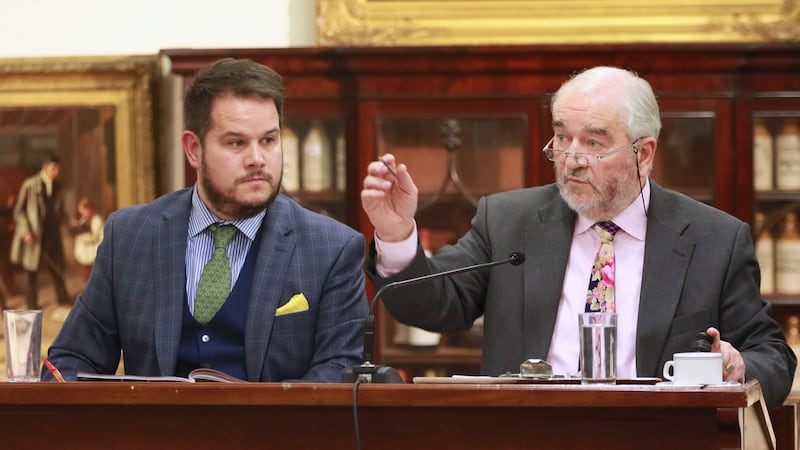It’s lunchtime at the summer fine art sale at Fonsie Mealy Auctioneers in Castlecomer, Co Kilkenny, and Jim McLean has already got what he came for.
“It’s indescribable, quite frankly. It’s ghastly. You’ll see when it comes out,” he says, waiting by the side door to pick up his haul.
The lots attracting all the headlines today are maritime paintings from the collection of Adm Charles Beresford, old militaria, weapons, and several antique doll’s houses from the Tara’s Palace museum. One of the doll’s houses will later sell, to everyone’s shock, for €48,000.

Reading the room is what any auctioneer worth his salt will do
But McLean isn’t here for any of that. He came to the auction this morning hoping to buy “rugs, a few lamps, things like that” for a farmhouse he and his wife recently bought in Wexford. He ended up with “a big yellow sofa, and a painting that my wife liked. And a wretched tiger head.”
What is a wretched tiger head? “Wait,” he says.
When the tiger’s head finally appears, “wretched” is not an unflattering description. “I know. I told you.” He sounds delighted.
“Someone’s Uncle Purvis shot him back in the raj.” He thinks for a moment. “I bet he didn’t though. Purvis probably bought it.”
As he lifts the snarling, moth-eaten head, chunks of plaster crumble to the ground. McLean doesn’t mind. It’s the tiger’s teeth he is after. “These two front teeth you take out, and you mount them in silver, and then they’re worth $200 (€180), $300 or $400 apiece” if you were to sell them online. He paid €70 for the head, plus two African gazelle skulls. But “I won’t be selling them, and in all honesty, I may not even take the teeth out. I might just have to enjoy him as he is for a while.”
McLean says he has a collection of “bizarre stuff, but great stuff” waiting to furnish the new house. “Canes with human bone tops. I sold my skull collection before I came to Ireland. I had a few-thousand-year-old Ethiopian warrior’s skull. I sold that for €1,000.”
Thrill
Sean Byrne is waiting to pick up a glass cabinet filled with stuffed woodland creatures, which he bought for €120. He only recently started collecting taxidermy, and this is his seventh piece. “You either love it, or you don’t. But I think it is a nice thing to have.” Mostly, he loves “the thrill of the auction”.
Ian Kidd motions me over to have a look inside the boot of his car, which is stuffed with what looks like the costume department of a period film set. He extracts a peaky blinder cap and a set of bayonets which, he says, were formerly the property of Lord Waterford. “That,” he pulls out a black shoulder bag, “is a cartridge pouch made of elephant skin.” He’s into period re-enactments, he explains.
Today, he acquired a German helmet from the first World War to add to the collection. “It’s untouched. It’s got the maker’s marks on it. With a little bit of oil, it will look really good. I already have an M16 German helmet and I have an M17, and now I have an M18. I’m a chronic collector of bits and pieces. I was born collecting. It’s kind of a bug.”
Not everyone at Fonsie Mealy’s auction house is interested in the historical, the quirky, or the plain old ghastly, but everyone here seems to have the bug.
For Barry Nangle, it’s all about brown furniture. “My ceilings are 9ft, so I’m lucky. I buy all the big furniture that nobody else will buy. It has to be mahogany. A lot of people don’t like it. They think of their granny.”
His best-ever buy at auction was an antique mahogany sleigh bed, which he got for €120. His tip to other prospective collectors is to look for clean lines. “A lot of it is too fussy. You want a plain piece that can go alongside something modern.”
Much has been written about the revival of interest in brown furniture, but Nangle thinks it’s been overstated – and at the auction we attend, a William IV library table, “possibly by Strahan”, which was guiding at €500-€700 goes for €300. Later, an Edwardian art nouveau display cabinet sells for €140, and a pair of Georgian mahogany upholstered armchairs sell for €80 for the pair.
Antique furniture is difficult to shift now, Fonsie Mealy admits. “The younger generation have no interest. It’s sad, but there is value out there.” Modern houses are too small to accommodate the proportions of a lot of old furniture and “it’s the way people are thinking colour-wise as well”.
The game has changed a lot since Mealy joined the business established by his father 50 years ago, but the biggest change has been the arrival of the internet. “Now people won’t come to the auctions” in the same numbers, which makes the auctioneer’s job much more difficult.
There’s an art and a psychology to the work of an auctioneer. “Reading the room is what any auctioneer worth his salt will do. He’ll be able to point out when somebody is going to bid, and you can nearly say when somebody is going to stop bidding as well.” You can’t do that when people are bidding online.
Waterford auctioneer Rody Keighery, who is here today to oversee 56 lots of weapons he’s selling on behalf of a client, agrees that “the internet has killed auctions. But only for the internet, we wouldn’t be alive.”
Mealy’s, he says, are “the arms people”. He won’t sell weapons anymore himself, not since an armed robbery at his own auction rooms five years ago, when his wife, Anne, was held at gunpoint. “Everybody said to me afterwards, ‘Was it a real gun?’” He puts a finger on my back. “Is that a real gun? You’re not going to take a chance. So we don’t do weapons anymore.”
Mealy says what keeps him hooked after all these years is the knowledge that you’re only ever “one phone call away from something surprising or something interesting”.
Sleeper lot
A few years ago, he got a call about some items being sold by three sisters, who were members of the aristocratic Anglo-Irish de Montmorency family of Castle Morres. One of the items was an outfit that used to belong to the governor of Punjab. It was stored in a trunk and when they took it out something else caught his eye. “On top of the trunk, as we opened it, was this Native American costume. They took it out and threw it on the ground. I said, what’s that? And they said, ‘that’s only mum’s fancy-dress costume’.”
Mealy asked if they’d be interested in selling it. He got the feeling, he says, the instinct that you’ve found something interesting. “I said to them, it’s probably worth four to six. Oh right so, they said, and they were delighted. So I put it on the catalogue and I had €4,000-€6,000 on it. And they said, is that a typo? And I said no, I did a bit of research, I think we’ll get it.”
On the day of the auction, there were 10 prospective buyers on the phone, and several in the room who had travelled from the US, with more bidding online. “I started the thing at €50,000, and the two women, they looked at one another, and they checked to see was there something wrong, was it the right lot?”
On and on it went, he says. Fifty, 55, 60, 65, 70, 75, 80. “At that stage, the two women were changing colour.” The lot eventually sold for €320,000, with commission on top.
Then there are the calls “where there is absolutely nothing in it. And you have to be diplomatic”. He once had a call from an acquaintance, who wanted him to sell two paintings she and her husband had valued by an English auction house at between €150,000 and €200,000. “They thought, that’s our pension, that’s our insurance.”
After the husband died unexpectedly, Mealy went to look at the paintings. “She showed me the valuation and she had a cup of tea made and she was waiting expectantly. So I said ‘Who came over to see them?’ And she said, ‘Oh no, nobody did we sent over the photographs.’ And I said, do you realise they are prints, not original paintings? She said, well why would that matter? And I said it matters very seriously.” He had to tell her they were worth between €400 and €500 for the pair.
“She burst into tears and cried for half an hour. I have always been afraid, ever since, of looking at things in photographs. You have to see it for yourself. Condition or anything else you cannot determine until you see it. And there are so many wonderful fakes being done now.”
David Parsons, in his 80s, who is here with his wife, Breda, thinks he has got one up on Fonsie. He bought a 19th-century sword – he has done his research, and believes it was one of a kind used by police officers and in prisons. It’s a bargain at €400, he says. What will he do with it? “I shall keep it. That won’t be for very long, I wouldn’t have thought. And then it will go to my daughter who will immediately tip it into the nearest pawn shop and buy something totally useless, like clothes or shoes.” He’s laughing now.
He has his eye on an ebony cabinet his daughter likes. Has she given him a budget? “No, budgets don’t come into it. She knows damn well I’m not going to take any money from her.” I watch him later when his daughter’s lot comes up, holding his number up continuously, until the competition gets scared off and the gavel comes down at €380.
There’s a third generation of the family: Fonsie’s son George, now interested in the business. From the age of nine or 10, he started helping out in the auction house. “The calling was there.” These days, they run the auctions as a duo, taking 100 lots or so each before handing the gavel to the other.
On the day I visit, George Mealy is particularly excited by the sale of the Tara’s Palace collection of doll’s houses. Several of them come from a collection formerly belonging to Vivien Greene, the wife of novelist Graham Greene, and the proceeds are due to go to several children’s charities.
“It’s personally important to me because my eldest daughter Beatrice has neuropathy and she benefits from the services of Enable Ireland and Temple Street [children’s hospital],” George says.
The first two lots go largely as expected, making €12,000 and €6,000. The atmosphere in the room is muted when the third doll’s house comes up. The guide is €3,000-€4,000, but the bidding quickly surpasses €10,000. There is a sharp intake of breath when it passes €20,000, which gives way to nervous laughter when it reaches €30,000. Fonsie eventually brings the hammer down at €48,000. He maintains his professional composure throughout, but afterwards, he admits, that “when it went over the €20,000 mark, I said this is mad”.
Later, though, he says it’s not the big sales that he loves most, or the junk that turns out to be treasure. It’s the stories. “I love meeting people. You meet all kinds of people. And everybody has a story.”











